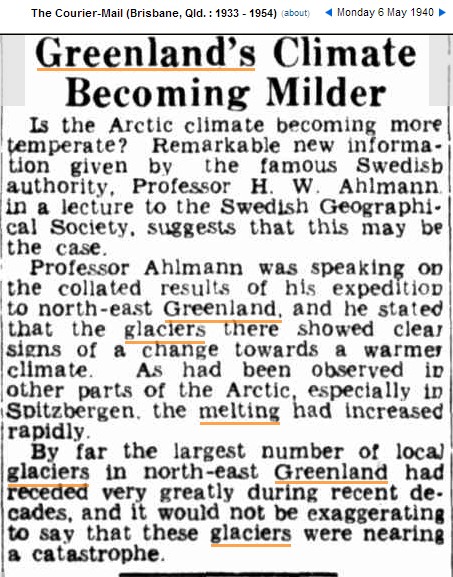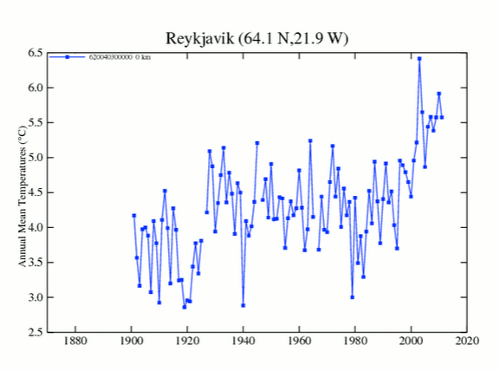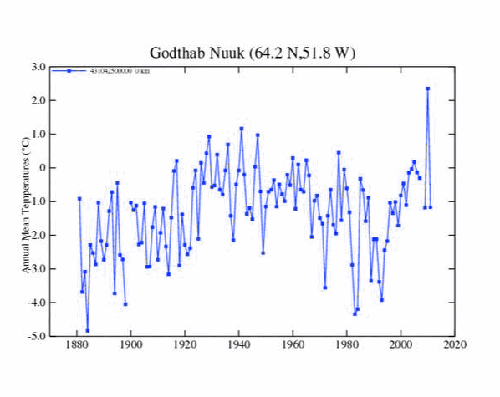By far the largest number of local glaciers in north-east Greenland had receded very greatly during recent decades, and it would not be exaggerating to say that these glaciers were nearing a catastrophe.
Fortunately, NASA has recently erased the 1940 warm period in that region, retroactively saving the glaciers.





One place was not erased.
Look at the MET PDF piece from November 2012 that you published. On page 18, the record of the “historical” permafrost shows a rapid melt to the lowest level reached to that date in the middle of the century, followed by a freeze never exceeded yet through the mid 1960s.
I wonder where their permafrost data is from. I’d guess they’d have changed it had they thought about the implications — as it is not reflected in the now-modified temperature records.
Speaking of which, can you point me to data for the Reykjavik before/after series?
===|==============/ Keith DeHavelle
GISS is down and they have probably changed that data set half a dozen times since that capture
Understood. I was hoping for your previously snagged data points, to save the trouble of digitizing these.
===|==============/ Keith DeHavelle
Those are screenshots of GISS plotted graphs
Holy merde – the 1940 data point appears to swing by 9C!!!
That’s one Hansen-load of adjustment!,
At some point, this crap needs to be prosecuted as criminal fraud.
Not quite — it’s the points just before and after. Note carefully the shape of 1939-1941, which you can identify using the top tick marks.
It’s about a 2° swing, still very substantial in this context.
===|==============/ Keith DeHavelle
Reblogged this on Edonurwayup's Blog and commented:
We need to hit the WC hard like David to Goliath.
Reykjavik
Greenland
Reykjavik
Greenland
Reykjavik
Greenland
One of these things is not like the other – oh wait, there’s only two things!
Reykjavik is a city on Iceland. Iceland is a small island, surrounded by ocean waters that don’t freeze over, 1/20th the size of Greenland and lies almost 20 degrees latitude south of northern Greenland and 7 degrees south of central Greenland. Only an idiot would put up a temperature graph for a city and use it as a stand-in for a land it’s not even a part of – might as well use Havana temperatures as a stand in for Mexico City to Boise, Idaho.
Glad to see you’re still insane and your posse isn’t smart enough to point out even the silliest tripe you put out.
ROFLMAO. Most people with an IQ over 30 would be able to identify that Greenland and Iceland are in the same “region” but that would appear to exclude Kevin
OKneel!
Good to see there are still some lemmings who have not jumped off the cliff!
Did your meds run out before you left the precipice?
You still aren’t making any sense, but that’s not what’s important. You can at least form complete sentences (well some of the time).
In other words, just because they would so blatantly adjust records in that region doesn’t mean a Godthab thing to you, does it?
===|==============/ Keith DeHavelle
Greenland belongs to Denmark, maybe they have the data when NASA is down or when they tamper with it.
Earth to Kevin. It’s like using Havana data to stand in for Jamaica or Puerto Rico. Take a look at a map, and tell me which Caribbean Island is Boise, Idaho. I can’t find it.
Here is the plaintext …